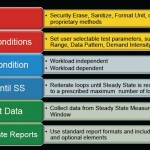Join SSSI members for an “open” call on March 10, 2014 at 7:00 pm ET/4:00 pm PT. SSSI member Jerome McFarland, Principal Product Marketer at Diablo Technologies, will talk about how memory channel storage technology works, how it’s deployed, and its advantages for applications.
Dial in at 1-866-439-4480 passcode 57236696. A WebEx will be available at http://snia.webex.com, meeting number 792 152 928, password sssipcie.
The SSSI PCIe SSD Committee is a SSSI member committee that provides guidance to the marketplace on SSDs. This can take the form of educational materials, best practices documents, and SNIA standards.
The “open” calls of the SSSI PCIe SSD Committee are designed to foster a broad understanding of technologies. All SNIA and SSSI members, and those who are simply interested in technology advances, are welcome to attend. Spread the word!
